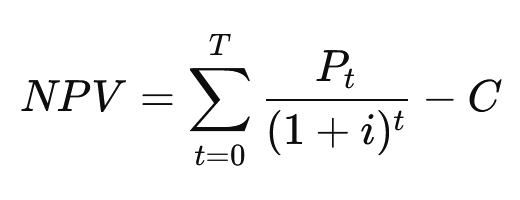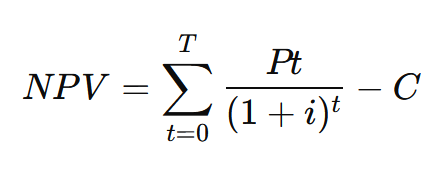Managing Innovation and Entrepreneurship - 5
 Vishesh Raghuvanshi
Vishesh Raghuvanshi
Measurement and Evaluation of the Benefits of Innovation for Business
Measuring and evaluating the benefits of innovation is crucial for businesses to understand the impact of their innovative efforts and to make informed decisions about future investments. This involves assessing both financial and non-financial metrics, and often requires a combination of these to get a comprehensive view.
Financial Metrics
Financial metrics are the most commonly used methods for assessing the benefits of innovation. These metrics provide a quantitative basis for comparing different projects and making investment decisions.
Payback Period:
Definition: The payback period is the time it takes for an investment to generate an amount of money equal to the cost of the investment.
Usefulness: It is a simple and easy-to-understand metric, useful for quick assessments.
Return on Investment (ROI):
Definition: ROI measures the gain or loss generated by an investment relative to its cost.
Formula:

Usefulness: It provides a percentage measure of profitability.
Net Present Value (NPV):
Definition: NPV calculates the present value of future cash flows generated by an investment, minus the initial investment cost.
Formula:

where Pt is the forecast cash flow in time period t, T is the project life, i is the discount rate, and C is the initial investment cost.
Usefulness: NPV accounts for the time value of money and provides a more accurate measure of an investment’s profitability over time.
Discounted Cash Flow (DCF):
Definition: DCF analysis uses future free cash flow projections and discounts them to arrive at a present value estimate.
Usefulness: It helps in evaluating the attractiveness of an investment by considering the present value of expected future cash flows.
Non-Financial Metrics
Non-financial metrics are also important as they capture aspects of innovation that financial metrics might miss, such as customer satisfaction, brand value, and knowledge creation.
Customer Satisfaction:
Definition: Measures how products or services meet or surpass customer expectations.
Methods: Surveys, Net Promoter Score (NPS).
Usefulness: Indicates the potential for customer loyalty and repeat business.
Brand Value:
Definition: The perceived value of a brand in the market.
Methods: Brand equity surveys, market research.
Usefulness: Reflects the competitive position and market influence of the company.
Knowledge Creation:
Definition: The accumulation of firm-specific knowledge that can be useful for future innovations.
Methods: Counting patents, scientific publications, and other intellectual properties.
Usefulness: Indicates the firm's capacity for ongoing innovation and long-term competitive advantage.
Combining Financial and Non-Financial Metrics
For a comprehensive evaluation, businesses often combine financial and non-financial metrics. This approach ensures that both tangible and intangible benefits of innovation are considered.
Balanced Scorecard:
Definition: A strategic planning and management system used to align business activities to the vision and strategy of the organization.
Components: Financial metrics, customer knowledge, internal processes, and learning and growth perspectives.
Usefulness: Provides a balanced view of performance and helps in tracking the execution of activities.
Innovation Audit:
Definition: A systematic examination of the innovation process and its outcomes.
Components: Inputs (resources, time, money), processes (innovation management practices), and outputs (results, impacts).
Usefulness: Helps in identifying strengths and weaknesses in the innovation process and provides insights for improvement.
Choice of Metrics
The choice of metrics depends on several factors including the nature of the innovation, the industry, the company’s strategic objectives, and the specific context of the innovation project.
Strategic Alignment:
Ensure metrics align with the company’s overall strategic goals.
Metrics should support long-term objectives, such as market leadership or sustainable growth.
Relevance and Reliability:
Select metrics that provide reliable data and relevant insights.
Avoid metrics that are too complex or difficult to interpret.
Balanced Approach:
Use a mix of financial and non-financial metrics to capture a full picture of innovation performance.
Regularly review and update metrics to ensure they remain relevant and aligned with business goals.
Barriers to Innovation in Business
Innovation is essential for business growth and competitiveness, but many organizations face significant barriers that can hinder their ability to innovate effectively. Understanding these barriers is the first step towards overcoming them and fostering a culture of innovation.
Types of Barriers to Innovation
- Economic Barriers:
Cost vs. Benefit: Individuals or organizations often face economic barriers when the personal costs of adopting a new innovation outweigh the perceived benefits. This can include initial investment costs, ongoing maintenance costs, or the cost of switching from an old system to a new one.
Access to Information: Limited access to relevant information about new technologies or innovations can hinder adoption. Without adequate knowledge, decision-makers may be reluctant to invest in something new and unproven.
Insufficient Incentives: Often, there are not enough incentives for businesses to innovate, especially if the current systems are functioning adequately. This can be due to market conditions, lack of competitive pressure, or regulatory environments that do not reward innovation.
- Behavioral Barriers:
Priorities and Motivations: Individuals and organizations may prioritize other activities over innovation, focusing on immediate operational concerns rather than long-term innovation strategies.
Rationality and Inertia: Behavioral inertia, where organizations stick to known and familiar practices, can prevent the adoption of new innovations. This is often due to risk aversion and the natural human tendency to resist change.
Propensity for Change or Risk: The willingness to adopt innovations can be significantly influenced by the propensity of individuals or organizations to take risks. Low risk tolerance can be a major barrier to adopting new and untested innovations.
- Organizational Barriers:
Goals and Routines: Established goals and routines within an organization can create resistance to change. Innovations often require a shift in operational procedures, which can be met with resistance from employees and management.
Power and Influence: Organizational politics, where certain groups or individuals hold power, can inhibit innovation if these stakeholders view new ideas as a threat to their influence or position.
Culture and Stakeholders: An organization's culture plays a critical role in innovation. A culture that does not support experimentation, creativity, or risk-taking will hinder innovation efforts. Additionally, stakeholders' resistance to change can be a significant barrier.
- Structural Barriers:
Infrastructure: The existing infrastructure of an organization can limit its ability to adopt new innovations. This includes physical infrastructure, technological systems, and organizational processes that may not be compatible with new innovations.
Sunk Costs: Investments in existing technologies and systems can create a barrier to innovation, as organizations may be reluctant to abandon these investments in favor of new, uncertain innovations.
Governance: The regulatory and governance frameworks within which an organization operates can either facilitate or hinder innovation. Strict regulations, compliance requirements, and bureaucratic red tape can slow down or completely block innovation efforts.
Specific Challenges in Innovation
Not-Invented-Here Syndrome
- Organizations may reject external ideas because they were not developed internally, leading to missed opportunities.
Core Rigidities
- Strengths and competencies that were once advantageous can become rigidities, preventing adaptation to new technologies and market demands.
Strategic Niches
- Innovations often start in niches with different goals and practices. These niches may struggle to influence the mainstream market without proper support.
Diffusion and Technology Transfer
- The process of spreading new products or ideas (diffusion) and moving ideas from the lab to the market (technology transfer) can be hampered by these barriers.
Case Studies and Examples
Western Union and Alexander Graham Bell
Overview: In the late 19th century, Alexander Graham Bell offered to sell his telephone patent to Western Union for $100,000. Western Union, a dominant telegraph company at the time, declined the offer.
Barrier: Economic and Organizational Barriers
Economic: Western Union did not see the financial benefits of investing in the telephone technology over their existing telegraph infrastructure.
Organizational: The company was heavily invested in the telegraph system, both financially and operationally, creating a significant sunk cost barrier.
Outcome: Bell's telephone eventually revolutionized communication, proving Western Union's decision to be a major missed opportunity in innovation.
Kodak and Digital Photography
Overview: Kodak, a pioneer in photographic film, faced a major innovation barrier with the advent of digital photography.
Barrier: Organizational and Structural Barriers
Organizational: Kodak’s corporate culture and structure were deeply rooted in film photography, leading to a resistance to change.
Structural: Significant investments in film manufacturing infrastructure acted as a sunk cost barrier, making it difficult to shift to digital.
Outcome: Kodak filed for bankruptcy in 2012 after failing to adapt to the digital revolution, despite having developed the first digital camera in 1975.
Nokia and the Smartphone Market
Overview: Nokia was once the world's largest mobile phone manufacturer but failed to transition effectively to the smartphone market.
Barrier: Behavioral and Organizational Barriers
Behavioral: Nokia's management underestimated the importance of software and ecosystem in the smartphone market, focusing instead on hardware.
Organizational: The company's hierarchical and rigid management structure slowed down decision-making and innovation.
Outcome: Nokia’s market share plummeted as competitors like Apple and Samsung dominated the smartphone market. Nokia eventually sold its mobile phone business to Microsoft.
Polaroid and Digital Imaging
Overview: Polaroid, famous for its instant cameras, struggled to adapt to the digital imaging era.
Barrier: Economic and Core Rigidities
Economic: The company had significant investments in its instant film technology, which created financial barriers to pivoting to digital.
Core Rigidities: Polaroid’s core competencies in chemical-based film technology became rigidities that hindered adaptation to digital innovations.
Outcome: Polaroid filed for bankruptcy twice, in 2001 and 2008, due to its failure to innovate and keep pace with digital photography advancements.
Blockbuster and Online Streaming
Overview: Blockbuster, once a leader in video rentals, failed to transition to the emerging online streaming market.
Barrier: Behavioral and Structural Barriers
Behavioral: Blockbuster’s executives were slow to recognize the shift in consumer preferences towards online streaming.
Structural: The company’s extensive network of physical stores became a liability as the market moved towards digital.
Outcome: Blockbuster declared bankruptcy in 2010, while Netflix, which had initially approached Blockbuster for a partnership, emerged as a dominant player in the streaming industry.
General Motors in the 1980s
Overview: During the 1980s, GM faced significant competition from Japanese automakers like Toyota and Honda.
Barrier: Organizational and Cultural Barriers
Organizational: GM’s bureaucratic and hierarchical structure slowed down innovation and adaptation to new manufacturing techniques.
Cultural: There was a strong resistance to adopting lean manufacturing practices that were becoming popular in Japan.
Outcome: GM’s market share and profitability suffered as Japanese automakers gained a reputation for quality and efficiency.
Strategies for Overcoming Barriers
Creating a Supportive Culture:
Leadership Commitment: Leaders must actively support and participate in innovation initiatives, demonstrating commitment to change.
Encouraging Experimentation: Foster an environment where experimentation is encouraged, and failures are seen as learning opportunities.
Rewarding Innovation: Implement reward systems that recognize and incentivize innovative thinking and actions.
Enhancing Collaboration and Communication:
Cross-Functional Teams: Promote collaboration across different departments to leverage diverse perspectives and expertise.
Open Innovation: Engage with external partners, including customers and suppliers, to co-create and source innovative ideas.
Improved Communication Channels: Develop robust communication channels to facilitate the exchange of ideas and information.
Providing Adequate Resources:
Innovation Budgets: Allocate dedicated budgets for innovation projects to ensure they have the necessary resources.
Access to Tools and Technologies: Provide access to the latest tools and technologies that can aid in the innovation process.
Time for Creativity: Allow employees time within their work schedules to explore and develop new ideas.
Building Innovation Capabilities:
Training and Development: Offer training programs to build skills that support innovative thinking and problem-solving.
Innovation Processes: Establish clear processes and frameworks for managing innovation projects, from ideation to implementation.
Knowledge Management: Implement systems for capturing and sharing knowledge within the organization to facilitate continuous learning.
Adopting a Long-Term Perspective:
Balanced Metrics: Use a mix of short-term and long-term metrics to evaluate the success of innovation initiatives.
Sustained Effort: Recognize that innovation is a long-term commitment and requires sustained effort and investment.
Adaptability: Develop the ability to adapt and pivot strategies as new information and opportunities arise.
Encouraging Intrapreneurship:
Empowering Employees: Empower employees to take ownership of their ideas and provide the support needed to develop them.
Internal Incubators: Create internal incubators or innovation labs where employees can experiment with and develop new ideas.
Mentorship Programs: Establish mentorship programs to guide and support employees working on innovative projects.
Innovation Failure and Its Causes
Innovation is inherently risky and prone to failure. Understanding why innovations fail is crucial for businesses to learn, adapt, and improve their innovation strategies. Innovation failures can be due to various factors, ranging from market misjudgments to organizational issues. Recognizing and analyzing these causes can provide valuable insights for future endeavors.
Causes of Innovation Failure
Market Misjudgments
Misunderstanding Customer Needs: One of the primary reasons for innovation failure is not aligning the product or service with customer needs. Companies often innovate based on assumptions rather than thorough market research, leading to products that do not meet market demands.
Poor Market Timing: Timing is critical in innovation. Launching a product too early or too late can result in failure. Early launches may suffer from undeveloped markets, while late entries may face saturated markets with established competitors.
Organizational Factors
Lack of Clear Vision and Strategy: Innovations often fail due to a lack of a clear vision and strategic direction. Without a well-defined strategy, innovation efforts can become fragmented and lack coherence.
Inadequate Resources: Insufficient allocation of resources, including financial, human, and technological resources, can cripple innovation projects. Innovations require sustained investment and support to succeed.
Resistance to Change: Organizational inertia and resistance to change are significant barriers. Employees and management may resist new ideas and processes, preferring to stick with familiar methods.
Execution Failures
Poor Project Management: Effective project management is crucial for innovation. Failures often result from poor planning, execution, and monitoring of innovation projects. Clear milestones, responsibilities, and timelines are essential.
Inadequate Testing and Validation: Skipping thorough testing and validation phases can lead to launching flawed products. Rigorous testing ensures that innovations meet quality standards and function as intended.
External Factors
Regulatory Challenges: Innovations may face regulatory hurdles that can delay or prevent their adoption. Navigating these challenges requires understanding and complying with relevant regulations.
Economic Conditions: Unfavorable economic conditions, such as recessions or economic downturns, can negatively impact the success of innovations. Consumers and businesses may cut back on spending during tough economic times.
Learning from Failure
Insights from Failure
Identifying What Not to Do: Failures provide critical insights into what does not work, helping organizations avoid similar mistakes in the future. This focusing process is vital for refining innovation strategies.
Building Capability: Learning from failure helps build organizational capability. Through trial and error, organizations develop the skills and processes needed to manage innovation more effectively.
Sharing Lessons: Sharing stories of failure within and outside the organization promotes a culture of learning. Vicarious learning from others' failures can guide and inform future innovation efforts.
Post-Project Reviews (PPRs)
Structured Learning: Conducting post-project reviews helps capture lessons from both successful and unsuccessful projects. These reviews should focus on learning rather than assigning blame.
Improving Future Projects: Insights from PPRs can be used to improve future innovation projects, enhancing the likelihood of success.
Case Studies and Examples
3M's Post-it Notes
Failure Turned Success: The invention of Post-it Notes by 3M originated from a failed attempt to create a strong adhesive. Reframing the problem and exploring new applications for the weak adhesive led to a highly successful product.
Culture of Experimentation: 3M's success with Post-it Notes underscores the importance of a culture that embraces failure as part of the innovation process.
Google's Perpetual Beta
Learning from Iteration: Google’s approach to innovation involves releasing products in a "perpetual beta" state, allowing continuous learning and improvement from user feedback.
Embracing Failure: Google's philosophy of "fail often to succeed sooner" highlights the value of failure in refining and improving innovations.
Post-Audits of Innovative Projects
Post-audits are a critical component of the innovation management process. They involve a systematic review of an innovative project after its completion to evaluate its success, learn from the experience, and identify areas for improvement. These audits help organizations understand the outcomes of their innovation efforts and refine their processes for future projects.
Objectives of Post-Audits
Performance Assessment: Measure the project's performance against its original objectives and key performance indicators (KPIs).
Learning and Improvement: Identify successes and failures to improve future innovation projects.
Accountability: Ensure resources were used efficiently and responsibly.
Knowledge Capture: Document lessons learned and best practices for future reference.
Strategic Alignment: Ensure the project aligned with the organization's strategic goals and innovation strategy.
Key Components of Post-Audits
Financial Performance: Analyze financial metrics such as return on investment (ROI), net present value (NPV), and payback period.
Market Impact: Assess market reception, including market share gained, customer satisfaction, and competitive advantage achieved.
Operational Efficiency: Evaluate improvements in operational processes, cost savings, and efficiency gains.
Technical Performance: Review technical objectives and performance, including innovation quality, technical challenges, and resolutions.
Strategic Impact: Examine the alignment with strategic goals, long-term benefits, and contribution to overall business strategy.
Learning Outcomes: Document lessons learned, best practices, and knowledge gained during the project.
Financial Metrics in Post-Audits
Return on Investment (ROI): Measures the profitability of the project relative to its cost.

Net Present Value (NPV): Calculates the present value of future cash flows generated by the project, discounted back to the present value.

where Pt is the forecast cash flow in period t, T is the project life, i is the discount rate, and C is the initial investment cost.
Payback Period: The time required for the project to repay its initial investment from its net cash inflows.
Non-Financial Metrics in Post-Audits
Customer Satisfaction: Measures customer satisfaction and feedback through surveys, reviews, and net promoter scores (NPS).
Employee Engagement: Assesses the impact of the project on employee morale, involvement, and retention.
Innovation Capability: Evaluates the development of new skills, knowledge, and capabilities within the organization.
Process Improvements: Measures enhancements in business processes, production methods, and operational efficiencies.
Sustainability Impact: Reviews the environmental and social impacts of the project, including sustainability initiatives and corporate social responsibility (CSR) outcomes.
Combining Financial and Non-Financial Metrics
A comprehensive post-audit should combine both financial and non-financial metrics to provide a holistic view of the project's impact. This approach ensures that both quantitative and qualitative aspects are considered, leading to more informed decision-making and better overall evaluation.
Choosing the Right Metrics
The choice of metrics should align with the project's objectives and the organization's strategic priorities. Key considerations include:
Relevance: Select metrics that are directly relevant to the project's goals and expected outcomes.
Measurability: Ensure that the chosen metrics can be accurately measured and quantified.
Balanced Perspective: Include both short-term and long-term metrics to capture immediate results and future potential.
Stakeholder Focus: Consider the interests and perspectives of all relevant stakeholders, including customers, employees, investors, and partners.
Conducting the Post-Audit
Planning and Preparation: Define the scope, objectives, and timeline of the post-audit. Identify key stakeholders and gather relevant data.
Data Collection and Analysis: Collect quantitative and qualitative data from various sources, including financial reports, customer feedback, and project documentation. Analyze the data to identify trends, patterns, and insights.
Review and Evaluation: Conduct a thorough review of the project's performance against its objectives. Evaluate both successes and challenges, and identify key learning points.
Reporting and Documentation: Prepare a detailed report documenting the findings, conclusions, and recommendations. Ensure that the report is clear, concise, and accessible to all relevant stakeholders.
Feedback and Continuous Improvement: Share the findings with the project team and other stakeholders. Use the insights gained to inform future innovation projects and drive continuous improvement.
Organization and Facilitation of an Innovation Workshop
An innovation workshop is a structured meeting designed to generate creative ideas and solutions through collaborative efforts. Effective organization and facilitation of such workshops are crucial for harnessing the creative potential of participants and driving innovation within an organization.
Objectives of an Innovation Workshop
Generate Ideas: Encourage brainstorming to produce a wide range of ideas.
Solve Problems: Address specific challenges and develop innovative solutions.
Build Teams: Foster teamwork and collaboration across different departments.
Develop Skills: Enhance participants' creativity and problem-solving skills.
Pre-Workshop Preparation
Define Goals and Objectives:
Clearly articulate the purpose of the workshop.
Set specific, measurable, achievable, relevant, and time-bound (SMART) goals.
Select Participants:
Include a diverse group from various departments and levels within the organization.
Ensure participants have complementary skills and perspectives.
Choose a Venue:
Select a location that is conducive to creativity and free from regular work distractions.
Ensure the venue has necessary facilities like breakout rooms, whiteboards, and internet access.
Prepare Materials:
Provide necessary tools such as post-it notes, markers, flip charts, and laptops.
Prepare any pre-reading materials or background information needed for the workshop.
Workshop Structure
Introduction and Icebreakers:
Begin with introductions to create a comfortable and open environment.
Use icebreaker activities to build rapport among participants.
Present the Challenge:
Clearly define the problem or opportunity to be addressed.
Provide relevant data and context to frame the discussion.
Idea Generation Techniques:
Brainstorming: Encourage free-flowing ideas without immediate criticism.
Mind Mapping: Visually organize ideas to see connections and hierarchies.
SCAMPER: Use this technique (Substitute, Combine, Adapt, Modify, Put to another use, Eliminate, Reverse) to think differently about the problem.
Idea Evaluation and Selection:
Use criteria such as feasibility, impact, and alignment with strategic goals to evaluate ideas.
Techniques like dot voting or prioritization grids can help in selecting the best ideas.
Prototyping and Testing:
Develop quick and simple prototypes of the selected ideas.
Test these prototypes in a controlled environment to gather initial feedback.
Action Planning:
Create detailed action plans for implementing the selected ideas.
Assign roles and responsibilities, and set deadlines for follow-up actions.
Facilitation Techniques
Maintain Focus:
Keep the discussion on track and ensure it aligns with the workshop’s objectives.
Use techniques like timeboxing (allocating fixed time slots for activities) to manage time effectively.
Encourage Participation:
Ensure everyone has a chance to contribute.
Use round-robin techniques or breakout groups to involve quieter participants.
Handle Conflict:
Be prepared to mediate disputes and keep the atmosphere positive.
Use techniques like "yes, and..." to build on ideas rather than dismiss them.
Record and Document:
Ensure that all ideas and discussions are recorded accurately.
Assign a scribe or use recording devices to capture the workshop outputs.
Post-Workshop Activities
Review and Reflect:
Hold a debrief session to reflect on what worked well and what could be improved.
Gather feedback from participants to improve future workshops.
Follow-Up:
Ensure that the action plans are implemented and monitored.
Schedule follow-up meetings to track progress and address any emerging issues.
Share Outcomes:
Communicate the results of the workshop to the broader organization.
Recognize and celebrate the contributions of participants to maintain engagement and motivation.
Best Practices
Create a Safe Space:
- Foster an environment where participants feel safe to share their ideas without fear of criticism.
Diversity of Thought:
- Encourage diverse perspectives to enhance creativity and innovation.
Iterative Approach:
- Be open to iterating on ideas and solutions based on feedback and testing.
Continuous Improvement:
- Treat each workshop as a learning opportunity to refine the process and improve outcomes over time.
Questions
What are the financial and non-financial metrics used for measuring the benefits of innovation for business? Discuss how these metrics can be combined and chosen appropriately.
Identify and explain the various barriers to innovation in business. How can companies overcome these barriers?
Analyze the common causes of innovation failure. Provide examples of companies that have experienced innovation failures and the lessons learned from them.
What are post-audits of innovative projects, and why are they important? Describe the steps involved in conducting a post-audit.
Discuss the organization and facilitation of an innovation workshop. What are the key elements to consider for ensuring its success?
Subscribe to my newsletter
Read articles from Vishesh Raghuvanshi directly inside your inbox. Subscribe to the newsletter, and don't miss out.
Written by
